Ninurta › Byzantine Empire » Ancient origins
Articles and Definitions › Contents
- Ninurta › Who Was
- Byzantine Empire › Antique Origins
Ancient civilizations › Historical and archaeological sites
Ninurta › Who Was
Definition and Origins
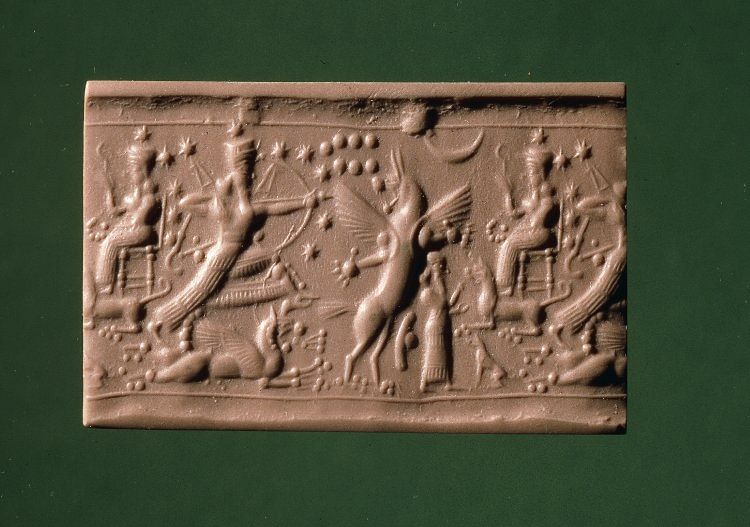
Ninurta (identified with Ningirsu, Pabilsag, and the biblical Nimrod) is the Sumerian and Akkadian hero-god of war, hunting, and the south wind. He first appears in texts in the early 3rd millennium BCE as an agricultural god and local deity of the town of Girsu (as Ningirsu) and the city of Larak (as Pabilsag), both Sumerian communities. His role as a god of agriculture changed as the cities of Mesopotamia increasingly militarized and began campaigns of conquest, one city against another.Scholar Stephen Bertman writes:
Ninurta began his divine career as a god of irrigation and agriculture. In fact, "The Instruction of Ninurta" is the title of an ancient Sumerian "farmer's almanac". But with the rise of imperialism he was transformed into a young and vigorous god of war. (124)
Ninurta was the son of Enlil and Ninhursag, but in some stories, Enlil and Ninlil. His wife was Gula, the goddess of healing (though in earlier inscriptions, as Ningirsu, he was married to the goddess Bau (also known as Baba). Although he was chiefly defined by his aggressive nature, he was also associated with healing and protection (hence his association with Gula) and was frequently invoked in magical spells to ward off danger, demons, and disease. He is most often represented as a warrior, sometimes with upraised wings, holding a bow and arrow and carrying his famous mace Sharur, a weapon capable of speech and reason. In Babylonian art, he stands or runs on the back of a scorpion-tailed lion-beast. Still, as late as c. 1500 BCE, he was still associated with agriculture, growth, and the harvest, depicted as a fully realized individual capable of great deeds but also as flawed as any mortal.
ALTHOUGH HE WAS CHIEFLY DEFINED BY HIS AGGRESSIVE NATURE, HE WAS ALSO ASSOCIATED WITH HEALING & PROTECTION.
The Assyrian and Neo-Assyrian empires embraced Ninurta as the son of their god Assur, and under the reign of Ashurnasirpal II (884-859 BCE) a great temple and ziggurat were built to the god in Ashurnasirpal II's new city of Kalhu.Seals from this time represent Assur as the winged disc, with Ninurta's name beneath, clearly suggesting the two were regarded as almost equals. Ninurta was invoked by numerous kingdoms and principalities in ancient Mesopotamia, whether for protection or aid in military matters, from c. 3300 - 612 BCE, when the Neo-Assyrian Empire fell to invaders. Early in his career, however, he was envisioned as the polar opposite of a war god.
NINURTA'S ORIGIN & SIGNIFICANCE
The god originated as Ningirsu ('Lord of Girsu') in Sumer, and the earliest texts use this name for the son of Enlil and Ninlil (although one myth suggests he is the son of Enlil and a she-goat). Gudea of Lagash (c. 2144-2124 BCE), noted for his piety and devotion to the gods, dedicated himself to Ningirsu, and his successor, Ur -Ningursu, would take the god's name to honor him. Gudea is probably best known for the Gudea Cylinders, two terracotta cylinders (dated to c. 2125 BCE) which record his dream in the text known as The Building of Ningirsu's Temple, the longest text in Sumerian yet discovered.
Ningirsu was already recognized as a war god by the 2nd millennium BCE where he is featured in the Babylonian work The Epic of Anzu. This myth would be revised during the 1st millennium BCE with Ningirsu's name changed to Ninurta. The god was already known by this later name (whose meaning is unknown) by c. 2600 BCE, and even though Ningirsu would continue to be referenced in Sumer, Ninurta would be the name most Mesopotamians knew and used. Even though he was considered a great warrior-god, champion of the gods, and protector of humanity, Ninurta continued to be associated with agriculture.
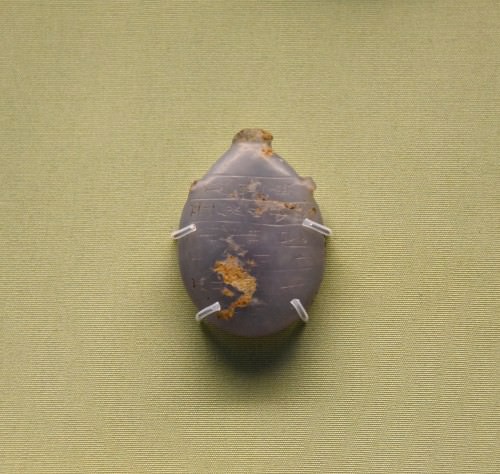
Ninurta Amulet
The Sumerians are well known for their technological inventions and innovations, and these were notably employed in early agriculture. Orientalist Samuel Noah Kramer writes:
Some of the more far-reaching technological achievements of the Sumerians were connected with irrigation and agruculture. The construction of an intricate system of canals, dikes, weirs, and reservoirs demanded no little engineering skill and knowledge. Surveys and plans had to be prepared which involved the use of leveling instruments, measuring rods, drawing, and mapping. Farming, too, had become a methodical and complicated technique requiring foresight, diligence, and skill. It is not surprising, therefore, to find that the Sumerian pedagogues had compiled a "farmer's almanac" that consisted of a series of instructions to guide a farmer throughout his yearly agricultural activities. (104-105)
This manual, the world's first farmer's almanac, dates to between 1700-1500 BCE and begins almost like a fairytale with the line, "In days of yore a farmer instructed his son..." and then goes on with practical instruction on how to get the most from the land. The piece goes into details on how to prepare the earth, how to plant the seed, even how to drive away birds, and the proper way to harvest the crop. Throughout the 35 lines of text, it seems as though this advice is being given by a father to his son, but in conclusion, the tablet reads, "These are the instructions of Ninurta, son of Enlil. O Ninurta, trustworthy farmer of Enlil, your praise is good." The farmer's instructions to his son, then, were given divine authority.
Ninurta's power and position in the Mesopotamian Pantheon would have lent significant weight to any document attributed to him, and especially so considering he would have had to take time out from heroic feats to offer his suggestions. The myths concerning Ninurta share many characteristics with those of the Babylonian god Marduk and the later Greek hero Heracles ( Roman Hercules ) in that he triumphs over the forces of chaos and establishes order (like Marduk), but his pride, like Hercules, can sometimes get the better of him.
NINURTA IN MYTH
In The Epic of Anzu (also known as The Defeat of Zu ), the Anzu bird has stolen the Tablets of Destiny from Enlil. These tablets hold the fate of gods and mortals and, equally important, legitimize the rule of whomsoever holds them. The Anzu bird, a divine creature of enormous size, waits for his chance to steal the tablets and one day, as Enlil is washing his face, the bird swoops in and snatches them.
He flies away while Enlil asks for help from the other gods. Only Ninurta comes forward and pursues the Anzu. The Tablets of Destiny, however, have the power to turn back time, and when Ninurta fires his arrows at the bird, they fall apart mid-air and revert to their components: the shafts return to the canebrake, the feathers to birds, the tip to the quarry. Even Ninurta's bow goes back to the woods and the bowstring to a sheep. Ninurta is driven back by the Anzu but calls upon the south wind, which tears the bird's wings off, dropping him to the ground. Ninurta then slits the Anzu's throat and brings the Tablets of Destiny back to Enlil.
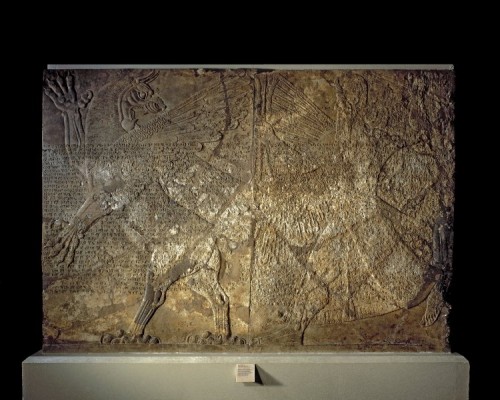
Ninurta & Anzu
In the poem Lugale (also known as The Exploits of Ninurta ), the hero must face the demon of sickness and disease known as Asag (also Agag) who lived in the underworld. This conflict is not initiated by Asag, however, but by Ninurta's mace, Sharur, who encourages him to go battle the demon by praising Ninurta's strength, courage, and skill, and telling him how easy it will be to defeat the creature. Ninurta goes to meet Asag in battle, but the demon is not alone; he has assembled an army of rock monsters and rebellious plants who march toward the hero. Ninurta is afraid (the text reads he "flees like a bird"), but Sharur tells him to turn around and face his enemies, encouraging him with reminders of past glories and the great fame he will win in victory. Ninurta destroys Asag and his army with his mace, great bow, and the other weapons he has in his belt.
Asag and his followers, however, kept the primeval waters of the underworld in check, and with their deaths, the brackish waters rise to flood the land. Nothing can grow because no fresh water can feed the crops. Ninurta took hold of the corpses of his enemies and piled them up to form a wall around the land and then piled them higher into a mountain to keep the waters of the underworld in place and then raised the River Tigris to water the land. The text reads:
Behold, now, everything on earth/Rejoiced afar at Ninurta, the king of the land/The fields produced abundant grain/The vineyard and orchard bore their fruit/The harvest was heaped up in granaries and hills/The lord made mourning to disappear from the land/he made happy the spirit of the gods. (Kramer, 152)
Ninurta's mother, Ninmah ('Magnificent Queen'), comes from heaven to rejoice at her son's victory and he dedicates the mountain of stone to her honor, renaming her Ninhursag ('Lady of the Mountain'). The goddess Nisaba appears to record Ninurta's triumph and Ninhursag's new name, and the poem ends with praise for the art of writing which preserves such moments eternally.
In the story of the Slain Heroes, Ninurta must defeat an assortment of strange creatures including the Six-Headed Wild Ram, the Palm-Tree King, the Strong Copper, and the Seven-Headed Snake. Some of these monsters are inanimate objects, like the Magillum Boat which brought the souls of the dead to the underworld, and others symbolize valuable material like Strong Copper. This myth with its theme of successive trials and victories is thought to have contributed to the Greek story of the Labors of Heracles.
Like Heracles, Ninurta is not always seen as the heroic champion, however, and in the story Ninurta and the Turtle, his pride overtakes his reason. The tablet is broken toward the end, and part of the introduction is missing, but the story seems to be set after Ninurta has defeated the Anzu and Asag and is being honored by Enki. Ninurta has brought a chick from the Anzu bird to the absu (the primeval watery depths) of Enki's home at Eridu. Enki praises Ninurta for his victories, for bringing the offspring of his enemy to Eridu, for returning the Tablets of Destiny; but Ninurta is angered by the accolades. He wants to achieve even greater victories and "set his sights on the whole world." Enki reads his thoughts and fashions a giant turtle which he releases behind the hero. The turtle bites and holds Ninurta's ankle, and as they struggle, the turtle digs an enormous pit with its claws which the two fall into.
Enki then looks down into the pit, where the turtle is chewing on Ninurta's feet, and mocks him saying, "You who made great claims - how will you get out now?" The conclusion is lost, but the turtle and the pit were intended to humble the hero and force him to recognize his limitations and also accept with gratitude the praise for his achievements instead of desiring greater glory, and it is assumed that Enki's scheme succeeded.
NINURTA IN THE NEO-ASSYRIAN EMPIRE
Even so, the glory he sought in the tale of the turtle was freely given by the great kings of the Assyrian Empire. Tukulti-Ninurta I (c. 1244-1208 BCE) honored the god by taking his name and invoking him in battle, crediting Ninurta with his spectacular military victories and successful reign. Tigleth Pileser I (c. 1115-1076 BCE) honored the god, as did Adad Nirari II (c. 912-891 BCE) and many others. No Assyrian king outdid Ashurnasirpal II, however, who built the city of Kalhu as the capital of the Neo-Assyrian Empire with the great Temple of Ninurta as his first project, decorating the walls with reliefs honoring the god's triumphs. One of the most famous Mesopotamian reliefs, often used on book covers or magazines dealing with the Near East, is of Ninurta and the Anzu bird from the temple at Kalhu. This temple not only served as a place of worship for the god but ministered to the poor, orphans, the homeless, and found work for itinerant laborers. The city's great temple and nearby towering ziggurat dedicated to Ninurta were known far beyond the boundaries of Mesopotamia.

Ashurnasirpal II Wall Relief
The fame of the hero-god Ninurta, as well as his city, is attested to in the Bible where Ninurta is known as Nimrod, who is described as "a mighty hunter" and Kalhu is given as Calah, "a great city" (Genesis 10:8-12). Nimrod, altered to Nimrud, would attach itself to the city of Kalhu in the 19th and 20th centuries CE when archaeologists took it for the city of Nimrod of the Bible. Some scholars have suggested that the biblical Nimrod is Tukulti-Ninurta I, but this claim is untenable. Tukulti-Ninurta I had nothing to do with Kalhu whereas Ashurnasirpal II more or less dedicated the entire city to Ninurta, and it would be this association remembered by the later Hebrew scribes who wrote the Genesis narrative.
Sargon II (722-705 BCE) built his city of Dur-Sharrukin ('Fortress of Sargon ') between 717-706 BCE and moved the capital there, but Kalhu continued to be highly respected; the queens of the empire were buried at Kalhu and the kings at the traditional site of the city of Ashur. During this period, Ninurta lost prestige because Sargon II favored the god of writing, Nabu, who was also considered a son of the high god Assur. Sargon II's successors, however, again elevated Ninurta, and he is mentioned frequently during the reigns of Esarhaddon (681-669 BCE) and Ashurbanipal (668-627 BCE).
Ashurbanipal was the last great king of the Neo-Assyrian Empire whose cities were sacked and looted in 612 BCE by a coalition of Medes, Babylonians, Persians, Scythians, and others who saw their chance to free themselves from Assyrian rule and took it. The great cities of Nineveh, Kalhu, Ashur, and the others were destroyed and the statues and temples of the Assyrian gods thrown down. Ninurta suffered the same fate as the other gods who had become closely associated with Assyrian rule, but the hero-god lived on through his influence on stories and myths of other cultures such as those of Greeceand Rome.
Byzantine Empire › Antique Origins
Definition and Origins
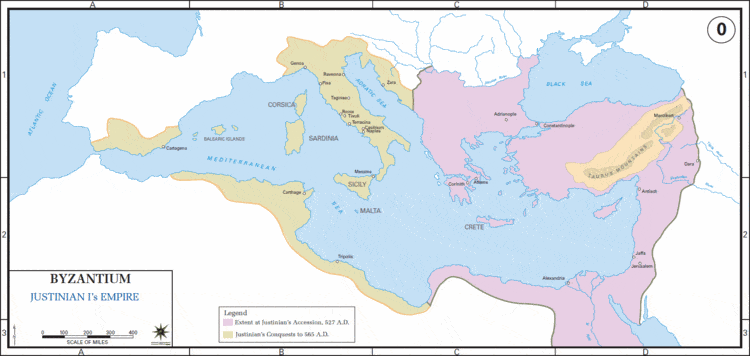
The Byzantine Empire was the continuation of the Eastern Roman Empire in the Greek -speaking, eastern part of the Mediterranean. Christian in nature, it was perennially at war with the Muslims, Flourishing during the reign of the Macedonian emperors, its demise was the consequence of attacks by Seljuk Turks, Crusaders, and Ottoman Turks.
Byzantium was the name of a small, but important town at the Bosphorus, the strait which connects the Sea of Marmara and the Aegean to the Black Sea, and separates the continents of Europe and Asia. In Greek times the town was at the frontier between the Greek and the Persian world. In the fourth century BCE, Alexander the Great made both worlds part of his Hellenistic universe, and later Byzantium became a town of growing importance within the Roman Empire.
By the third century CE, the Romans had many thousands of miles of border to defend. Growing pressure caused a crisis, especially in the Danube/Balkan area, where the Goths violated the borders. In the East, the Sasanian Persians transgressed the frontiers along the Euphrates and Tigris. The emperor Constantine the Great (reign 306-337 CE) was one of the first to realize the impossibility of managing the empire 's problems from distant Rome.
CONSTANTINOPLE
So, in 330 CE Constantine decided to make Byzantium, which he had refounded a couple of years before and named after himself, his new residence. Constantinople lay halfway between the Balkan and the Euphrates, and not too far from the immense wealth and manpower of Asia Minor, the vital part of the empire.
"Byzantium" was to become the name for the East- Roman Empire. After the death of Constantine, in an attempt to overcome the growing military and administrative problem, the Roman Empire was divided into an eastern and a western part. The western part is considered as definitely finished by the year 476 CE, when its last ruler was dethroned and a military leader, Odoacer, took power.
CHRISTIANITY
IN THE COURSE OF THE FOURTH CENTURY, THE ROMAN WORLD BECAME INCREASINGLY CHRISTIAN, & THE BYZANTINE EMPIRE WAS CERTAINLY A CHRISTIAN STATE.
In the course of the fourth century, the Roman world became increasingly Christian, and the Byzantine Empire was certainly a Christian state. It was the first empire in the world to be founded not only on worldly power, but also on the authority of the Church. Paganism, however, stayed an important source of inspiration for many people during the first centuries of the Byzantine Empire.
When Christianity became organized, the Church was led by five patriarchs, who resided in Alexandria, Jerusalem, Antioch, Constantinople, and Rome. The Council of Chalcedon (451 CE) decided that the patriarch of Constantinople was to be the second in the ecclesiastical hierarchy. Only the pope in Rome was his superior. After the Great Schism of 1054 CE the eastern (Orthodox) church separated form the western (Roman Catholic) church. The centre of influence of the orthodox churches later shifted to Moscow.
CULTURAL LIFE
Since the age of the great historian Edward Gibbon, the Byzantine Empire has a reputation of stagnation, great luxury and corruption. Most surely the emperors in Constantinople held an eastern court. That means court life was ruled by a very formal hierarchy. There were all kinds of political intrigues between factions. However, the image of a luxury-addicted, conspiring, decadent court with treacherous empresses and an inert state system is historically inaccurate. On the contrary: for its age, the Byzantine Empire was quite modern. Its tax system and administration were so efficient that the empire survived more than a thousand years.
The culture of Byzantium was rich and affluent, while science and technology also flourished. Very important for us, nowadays, was the Byzantine tradition of rhetoric and public debate. Philosophical and theological discources were important in public life, even emperors taking part in them. The debates kept knowledge and admiration for the Greek philosophical and scientific heritage alive. Byzantine intellectuals quoted their classical predecessors with great respect, even though they had not been Christians. And although it was the Byzantine emperor Justinian who closed Plato 's famous Academy of Athens in 529 CE, the Byzantines are also responsible for much of the passing on of the Greek legacy to the Muslims, who later helped Europe to explore this knowledge again and so stood at the beginning of European Renaissance.
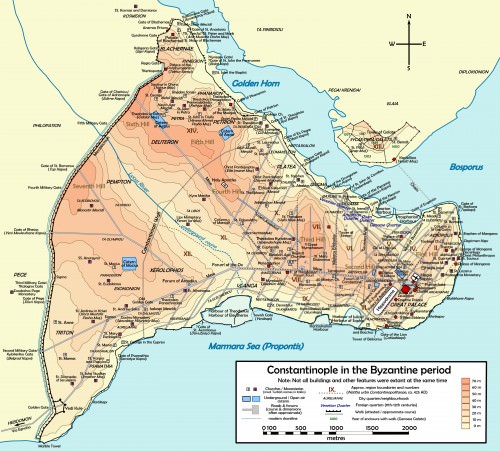
Map of Byzantine Constantinople
JUSTINIAN
Byzantine history goes from the founding of Constantinople as an imperial residence on 11 May 330 CE until Tuesday 29 May 1453 CE, when the Ottoman sultan Memhet II conquered the city. Most times the history of the Empire is divided into three periods.
The first of these, from 330 till 867 CE, saw the creation and survival of a powerful empire. During the reign of Justinian (527-565 CE), a last attempt was made to reunite the whole Roman Empire under one ruler, the one in Constantinople. This plan largely succeeded: the wealthy provinces in Italy and Africa were reconquered, Libya was rejuvenated, and money bought sufficient diplomatic influence in the realms of the Frankish rulers in Gaul and the Visigothic dynasty in Spain. The refound unity was celebrated with the construction of the church of Holy Wisdom, Hagia Sophia, in Constantinople. The price for the reunion, however, was high. Justinian had to pay off the Sasanian Persians, and had to deal with firm resistance, for instance in Italy.
Under Justinian, the lawyer Tribonian (500-547 CE) created the famous Corpus Iuris. The Code of Justinian, a compilation of all the imperial laws, was published in 529 CE; soon the Institutions (a handbook) and the Digests (fifty books of jurisprudence), were added. The project was completed with some additional laws, the Novellae. The achievement becomes even more impressive when we realize that Tribonian was temporarily relieved of his function during the Nika riots of 532 CE, which in the end weakened the position of patricians and senators in the government, and strengthened the position of the emperor and his wife.
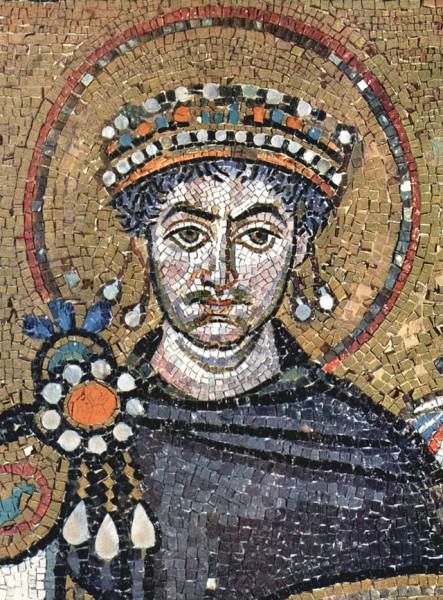
Justinian I
After Justinian, the Byzantine and Sasanian empires suffered heavy losses in a terrible war. The troops of the Persian king Khusrau II captured Antioch and Damascus, stole the True Cross from Jerusalem, occupied Alexandria, and even reached the Bosphorus. In the end, the Byzantine armies were victorious under the emperor Heraclius (reign 610-642 CE).
However, the empire was weakened and soon lost Syria, Palestine, Egypt, Cyrenaica, and Africa to the Islamic Arabs. For a moment, Syracuse on Sicily served as imperial residence. At the same time, parts of Italy were conquered by the Lombards, while Bulgars settled south of the Danube. The ultimate humiliation took place in 800 CE, when the leader of the Frankish barbarians in the West, Charlemagne, preposterously claimed that he, and not the ruler in Constantinople, was the Christian emperor.
MACEDONIAN DYNASTY
The second period in Byzantine history consists of its apogee. It fell during the Macedonian dynasty (867-1057 CE). After an age of contraction, the empire expanded again and in the end, almost every Christian city in the East was within the empire's borders. On the other hand, wealthy Egypt and large parts of Syria were forever lost, and Jerusalem was not reconquered.
In 1014 CE the mighty Bulgarian empire, which had once been a very serious threat to the Byzantine state, was finally overcome after a bloody war, and became part of the Byzantine Empire. The victorious emperor, Basil II, was surnamed Boulgaroktonos, "Slayer of Bulgars". The northern border now was finally secured and the empire flourished.
Throughout this whole period the Byzantine currency, the nomisma, was the leading currency in the Mediterranean world. It was a stable currency ever since the founding of Constantinople. Its importance shows how important Byzantium was in economics and finance.
Constantinople was the city where people of every religion and nationality lived next to one another, all in their own quarters and with their own social structures. Taxes for foreign traders were just the same as for the inhabitants. This was unique in the world of the middle ages.
CRISIS
Despite these favorable conditions, Italian cities like Venice and Amalfi, gradually gained influence and became serious competitors. Trade in the Byzantine world was no longer the monopoly of the Byzantines themselves. Fuel was added to these beginning trade conflicts when the pope and patriarch of Constantinople went separate ways in 1054 CE (the Great Schism).
Decay became inevitable after the Battle of Manzikert in 1071 CE. Here, the Byzantine army under the emperor Romanus IV Diogenes, although reinforced by Frankish mercenaries, was beaten by an army of the Seljuk Turks, commanded by Alp Arslan ("the Lion"). Romanus was probably betrayed by one of his own generals, Joseph Tarchaniotes, and by his nephew Andronicus Ducas.
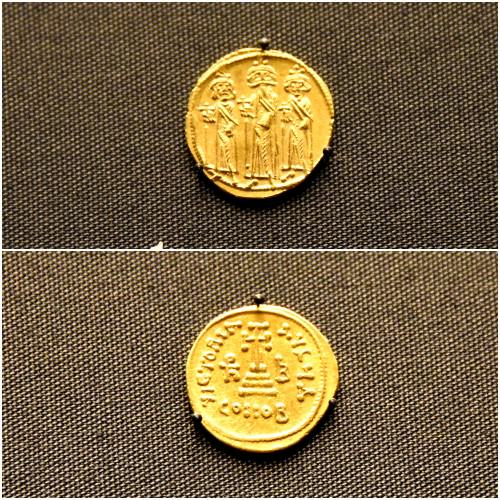
Byzantine coins of Heraclius
After the battle, the Byzantine Empire lost Antioch, Aleppo, and Manzikert, and within years, the whole of Asia Minor was overrun by Turks. From now on, the empire was to suffer from manpower shortage almost permanently. In this crisis, a new dynasty, the Comnenes, came to power. To obtain new Frankish mercenaries, emperor Alexius sent a request for help to pope Urban II, who responded by summoning the western world for the Crusades. The western warriors swore loyalty to the emperor, reconquered parts of Anatolia, but kept Antioch, Edessa, and the Holy Land for themselves.
DECLINE & FALL
For the Byzantines, it was increasingly difficult to contain the westerners. They were not only fanatic warriors, but also shrewd traders. In the twelfth century, the Byzantines created a system of diplomacy in which deals were concluded with towns like Venice that secured trade by offering favorable positions to merchants of friendly cities.
Soon, the Italians were everywhere, and they were not always willing to accept that the Byzantines had a different faith. In the age of the Crusades, the Greek Orthodox Church could become a target of violence too. So it could happen that Crusaders plundered the Constantinople in 1204 CE. Much of the loot can still be seen in the church of San Marco in Venice.
For more than half a century, the empire was ruled by monarchs from the West, but they never succeeded in gaining full control. Local rulers continued the Byzantine traditions, like the grandiloquently named "emperors" of the Anatolian mini-states surrounding Trapezus, where the Comnenes continued to rule, and Nicaea, which was ruled by the Palaiologan dynasty.
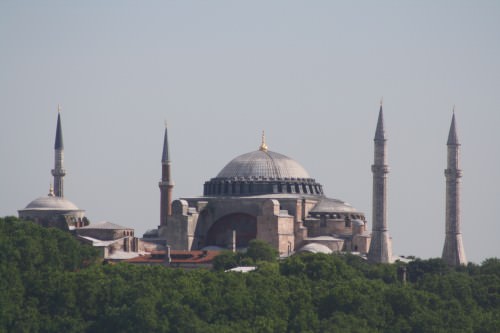
Hagia Sophia
The Seljuk Turks, who are also known as the Sultanate of Rum, benefited greatly of the division of the Byzantine Empire, and initially strengthened their positions. Their defeat, in 1243 CE, in a war against the Mongols, prevented them from adding Nicaea and Trapezus as well. Consequently, the two Byzantine mini-states managed to survive.
The Palaiologans even managed to capture Constantinople in 1261 CE, but the Byzantine Empire was now in decline. It kept losing territory, until finally the Ottoman Empire (which had replaced the Sultanate of Rum) under Mehmet II conquered Constantinople in 1453 CE and took over government. Trapezus surrendered eight years later.
ARTISTIC LEGACY
After the Ottoman take-over, many Byzantine artists and scholars fled to the West, taking with them precious manuscripts.They were not the first ones. Already in the fourteenth century, Byzantine artisans, abandoning the declining cultural life of Constantinople, had found ready employ in Italy. Their work was greatly appreciated and western artists were ready to copy their art. One of the most striking examples of Byzantine influence is to be seen in the work of the painter Giotto, one of the important Italian artists of the early Renaissance.
MAP
LICENSE:
Article based on information obtained from these sources:with permission from the Website Ancient History Encyclopedia
Content is available under License Creative Commons: Attribution-NonCommercial-ShareAlike 3.0 Unported. CC-BY-NC-SA License